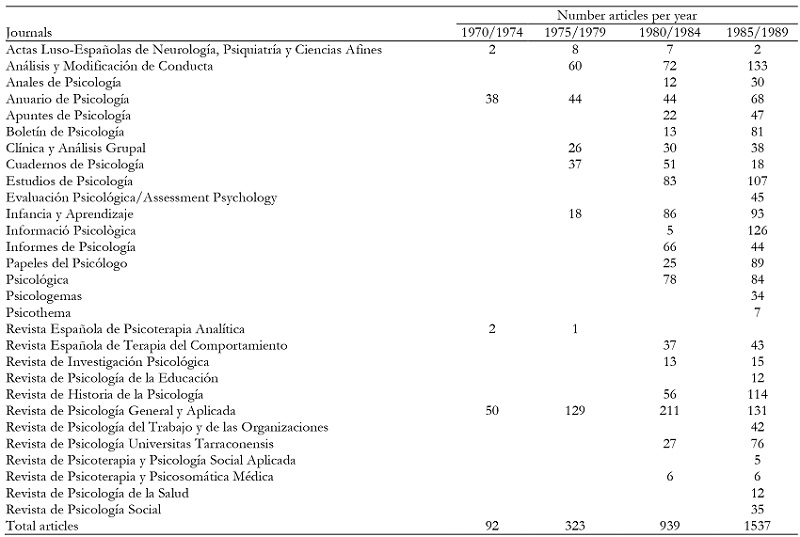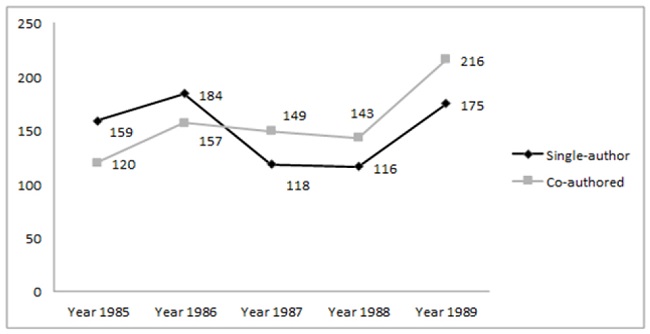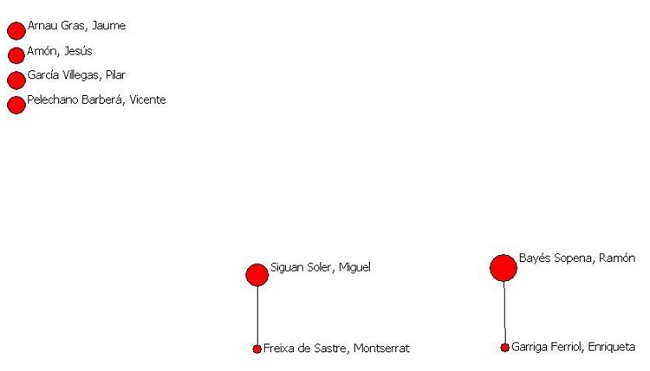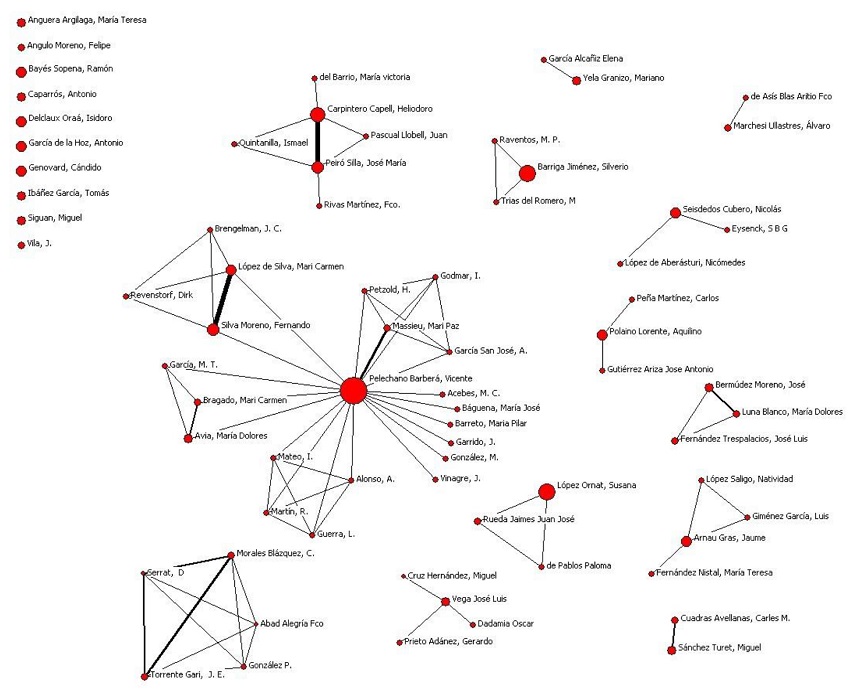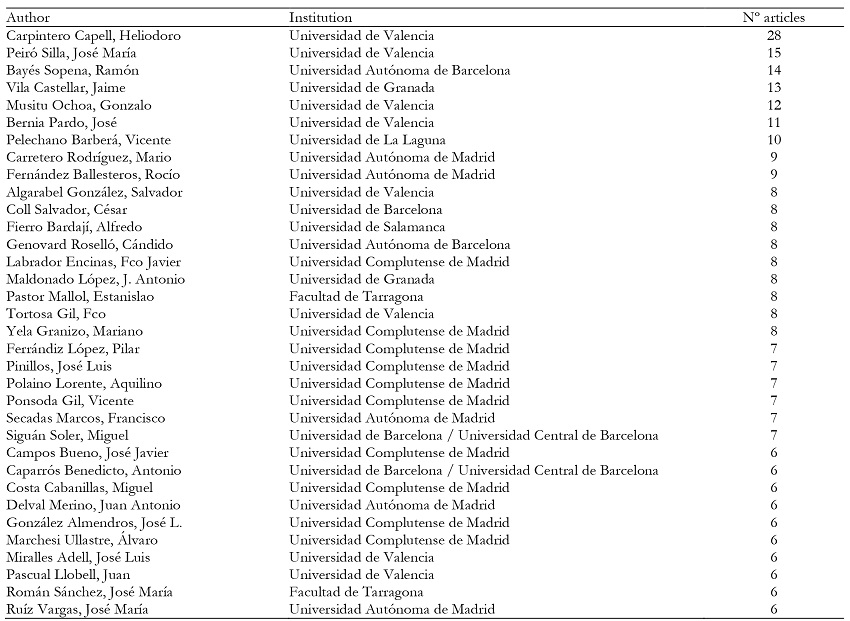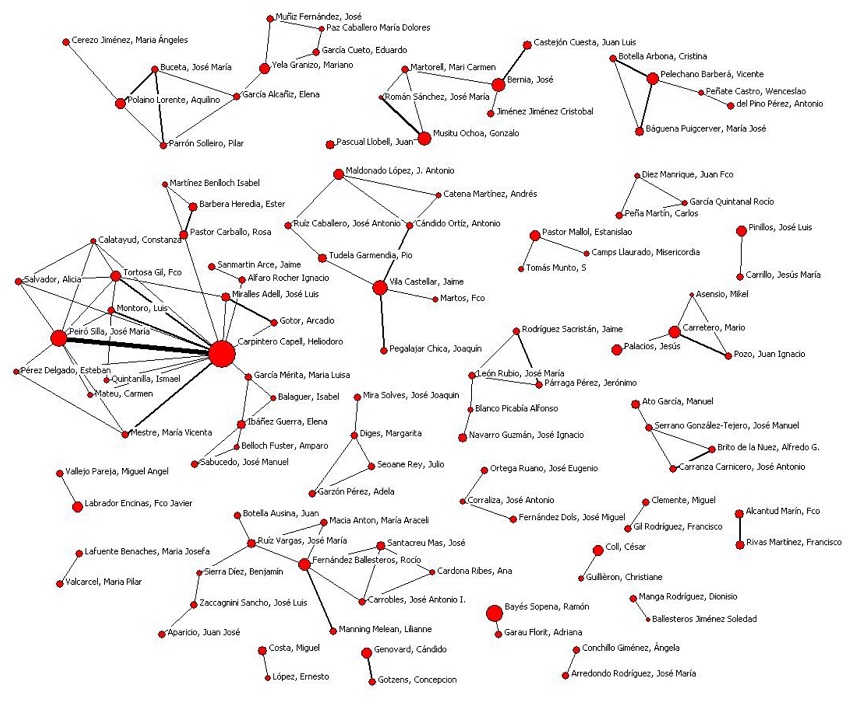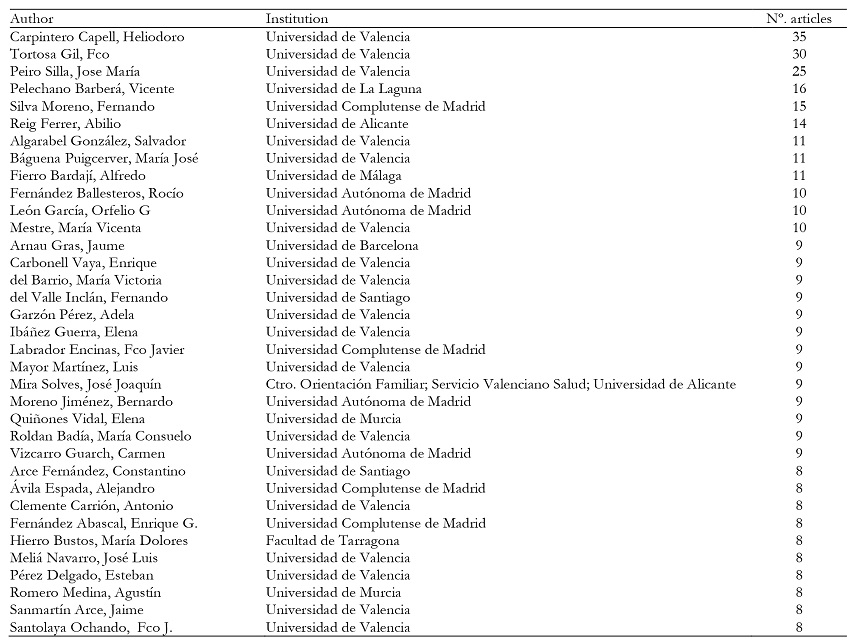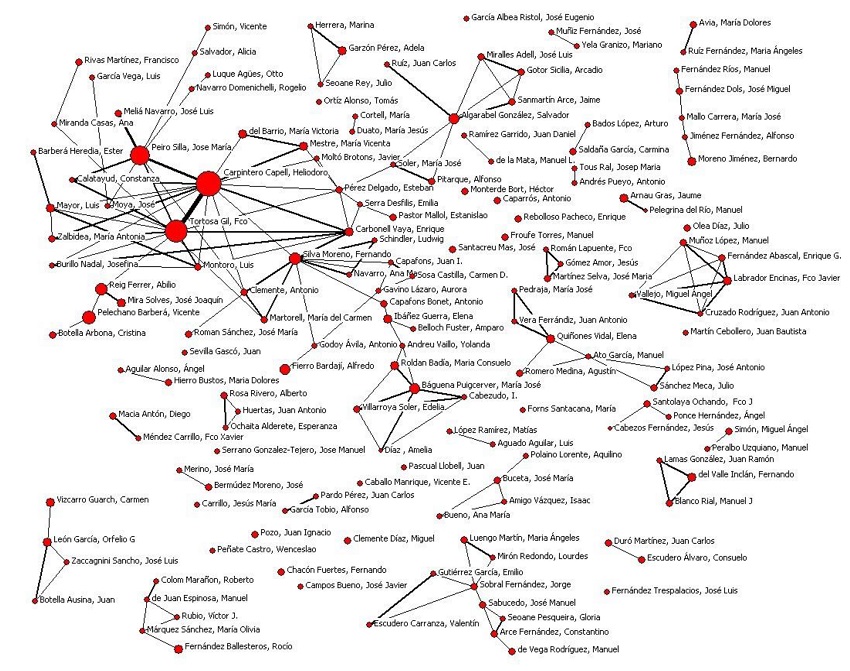Introduction
In order to understand current Psychology, and from a sociohistorical perspective, it is necessary to delve into the development of different variables which have somehow contributed to the development of this discipline. Since 1968, when the bachelor's degree in Psychology started to be taught in the Faculty of Philosophy and Literature from the Universidad de Madrid (Tortosa-Pérez et al., 2021), different events have marked the evolution of Spanish psychology: the 1973 study program differentiated between the degree in Philosophy, Learning Science and Psychology and the degree in Geography and History and in Philology; the Royal Decree 1652/1979, of 25 May (BOE of 5 July), which authorized the creation of the faculties of Psychology; or the establishment of Professional Associations of Psychology and Faculties of Psychology (31-12-1979), among others.
The 1970s are marked by the increase, dissemination, diversity, plurality, professionalization and institutionalization of Spanish Psychology (García, 2005). There is a change within psychologists' interests and the work methodology aimed at providing Psychology with an own scientific status (Carpintero & Tortosa, 1996). According to Vera (2005), the year 1979 is crucial in the development of Psychology due to its social and institutional positioning in our country.
As stated by Carpintero (1980), Carpintero and Peiró (1981a), Tortosa and Civera (2001) and Tortosa et al. (2019), the history of Psychology can be studied from the history of journals of psychology. On this basis, it is seen as appropriate to turn to this document type as a source of information which displays indicators, traits and aspects of scientific development. In the case of Spanish Psychology, its development is linked to the increase of scientific journals, among other factors. In this sense, Alcaín and Ruíz-Gálvez (1998) point out the increase of Psychology-related publications edited in Spain, which went from 18 journals between 1946 and 1978 to 48 journals between 1979 and 1988.
Numerous papers have tackled the study of the development of Psychology from the perspective of historiography. For example, papers by Blanco (1997), Carpintero et al. 2010, Civera et al. (2006), Fierro (2015), Germain (1954, 1980), Yela (1954, 1982) or Travieso et al. (2001) concerning the institutionalization process of Psychology. Other authors have focused on highlighting the contributions which have played a part in the development of Psychology (Carpintero, 2006; Herrero & Lafuente, 2004; Sáiz & Sáiz, 1996). Others have discussed about the leading figures (Alcover & Curras, 2013) or focused on studying scientific collaboration (López Ferrer & Osca, 2009; López Ferrer, 2008).
The study of scientific collaboration can be carried out from a sociobibliometric perspective, developed by Carpintero (1980, 1983a and b) and Carpinteró and Peiró (1983) to study the development of Psychology, which uses bibliometric methods and techniques (Carpintero & Peiró (1981b). In this sense, López Ferrer and Osca (2009) point out the relevance of bibliometric techniques and network analysis when studying scientific collaboration, becoming a useful tool in order to study the historic evolution of several scientific disciplines, or to analyse the social structure of the research groups. To this effect, different works have used this type of analysis when it comes to know the scientific collaboration among authors, institutions or countries, mainly within social sciences (López Ferrer et al., 2009; Molina, 2001; Osca et al., 2009).
Regarding Carpintero's hypothesis (1980), which considers science as an organization, we can understand the importance of scientific collaboration within this organization, considering this collaboration from the perspective of horizontality in opposition to verticality.
In the case of Psychology, scientific collaboration has increased over the years. López Ferrer and Osca (2009) indicate that between 1992 and 2001, 72.79 % of papers published by Spanish authors in journals of psychology included in the JCR databases had been carried out in collaboration, which increased by 35.49 % over these years.
This paper is aimed at analysing the evolution of scientific collaboration within Spanish psychology through papers signed by an author who belonged to a Spanish institution of psychology between 1970 and 1989. On this basis, we expect to find an increasement of scientific collaboration over the years, with the possibility of establishing a year from which the tendency of signing papers collaboratively is greater than individually signed papers; and conclude that the analysis of social networks is a useful tool when identifying collaborative groups, the researchers withing these groups and their evolution over time.
Method
Materials and Procedure
In order to carry out the research, we analysed 2891 papers published in a total of 29 journals of psychology. Table 1 shows the title of the journal and the number of papers included contemplating the analysed temporary period. The years, from 1970 to 1989, were selected considering the year when Professional Associations of Psychology and Faculties of Psychology were created, selecting a period of 10 years before and after this date.
Regarding the selection of papers, the inclusion criteria determined that it had to be a scientific article, either a review or discussion article, and it had to be signed at least by an author who belonged to a Spanish institution of psychology or who had studied psychology courses. As for the exclusion criteria, we did not include interviews, experiences, reports, conference communications, lectures, book reviews, nor papers in which it was not possible for us to identify whether at least one of the signatories belonged to a Spanish institution of psychology or had a bachelor's degree or a PhD in Psychology.
The identification of the journals included in this paper was carried out considering other works published previously on the evolution of Spanish Psychology, like the one by Tortosa and Civera (2001). Furthermore, we decided to include the Spanish journals of psychology which can now be found in JCR and which were already published in the analysed years, along with other journals which could be accessed through the library stock of the Universidad de Valencia. Following this, the selection of the authors' names and surnames and institutions was carried out, including these variables in an Excel spreadsheet. Subsequently, we standardized the data and searched the institutions in the cases in which this information did not appear in the paper.
Once the standardization process was completed, we carried out the analysis of social networks (ARS) through the program UCINET and through making graphics with Netdraw software (Borgatti, 2002; Borgatti et al., 2013) and counting frequencies. The size of the nodes indicates the total number of papers by an author. The nodes are greater when the production is greater, too. The links indicate what authors have signed a paper collaboratively and the thickness of the lines highlight the number of signatures which two authors share. Although for the network analysis we selected authors with three or more papers in the first three analysed periods, in the period between 1985 and 1989 we selected those authors with four or more papers, since the increase in the number of groups and authors made it impossible to appreciate the data represented in the figure.
Results
Number of collaborative and single-author papers between 1970 and 1989
Considering the analysed papers from the 29 journals which were subject of study, we retrieved a total of 4.865 author signings which correspond to 2.534 authors. During the analysed period, as reflected in Table 2, there is an increase in the number of collaboratively signed papers over the years. In the period between 1985 and 1989, there is a greater number of co-authored papers compared to single-author papers, as well as a greater average of signatures per paper, going from 2.35 signatures in the period between 1970 and 1974 to 2.72 signatures in the last period analysed.
When analysing the distribution of single-author and co-authored papers between 1985 and 1989, it is noted (see figure 1) how co-authored works predominate from 1987 on, a trend which will continue in subsequent years.
Analysis of collaboration networks in the period 1970 - 1974
During the five-year period 1970 - 1974, the number of signatures retrieved from papers published in the analysed journals was 120, which belonged to total of 92 authors. During this period, the greatest producers according to the number of signatures are the following: Ramón Bayés Sopena, from the Universidad Autónoma de Barcelona and the Galton Centre of Psychological Research (5 papers), Miguel Sigúan Soler, from the Universidad de Barcelona (4 papers) and Jesús Amón Hortelano, from the Universidad Autónoma de Madrid; Jaume Arnau Gras, from the Universidad de Barcelona; Pilar García Villegas, from the Instituto Nacional de Psicología Aplicada in Madrid; and Vicente Pelechano Barberá (from the Patronato de Asistencia Psiquiátrica in Madrid, the Universidad Complutense de Madrid and the Universidad Autónoma de Madrid), all of them with three papers.
Figure 2 represents the collaboration networks of authors who have signed three or more papers, along with all their collaborators. Out of the 6 authors who present a greater production during this period, 4 authors have carried out their works individually, without any collaboration. In this case, the nodes are isolated and appear on the left side of the figure. It can also be seen that there are 2 authors who have carried out a paper collaboratively, with the possibility of identifying two groups of authors. The first group is formed by Miguel Siguán Soler and Montserrat Freixa de Sastre, whereas the second one is composed by Ramón Bayés Sopena and Enriqueta Garriga Ferriol.
Analysis of collaboration networks in the period 1975 - 1979
The number of authors who have signed any paper in this period was 287, being responsible for a total of 470 signatures. Among the greatest producers, some prominent figures are Vicente Pelechano Barberá (Universidad de La Laguna), with 20 papers; Silverio Barriga Jiménez (Universidad Autónoma de Barcelona), with 11 papers; Susana López Ornat (Universidad Complutense de Madrid), with 10 papers; and Heliodoro Carpintero Capell (Universidad de Valencia), with 9 papers. With 7 papers, we can find José María Peiró Silla (Universidad de Valencia) and Fernando Silva Moreno (Universidad Complutense de Madrid). And with 6 papers: Jaume Arnau Gras, Cándido Genovard Roselló (Universidad Autónoma de Barcelona), Mari Carmen López de Silva (Medicine) and Aquilino Polaino Lorente (Universidad Complutense de Madrid).
Figure 3 shows the collaboration networks among authors who have signed three or more papers collaboratively, along with all their collaborations. Within the 13 groups which can be identified, the largest group is the one led by Vicente Pelechano and formed by a total of 22 authors. The second most important group, considering the number of authors, is the one led by Heliodoro Carpintero, which is formed by a total of 6 authors. They all belong to the Universidad de Valencia.
Analysis of collaboration networks in the period 1980 - 1984
The number of authors who have signed any paper in the period between 1980 and 1984 was 704, with a total of 1382 signatures. Some of the greatest producers are Heliodoro Carpintero Capell, with 28 papers, and José María Peiró Silla, with 15 papers, both from the Universidad de Valencia. Also, Ramón Bayés Sopena (Universidad de Granada), with 13 papers and Gonzalo Musitu Ochoa and José Bernia Pardo (Universidad de Valencia), with 12 and 11 papers, respectively. Table 3 reflects the authors who have published six or more papers during this five-year period, along with the institution they work in and the number of papers published in this period.
When depicting the collaboration network among authors who have signed three or more papers collaboratively, along with the authors who have collaborated with them during the conduct of 2 papers (see figure 4 ), it is possible to identify a total of 23 groups. The largest group is the one led by Heliodoro Carpintero Capell and formed by a total of 22 authors. The second most important group, considering the number of authors, is the one led by Rocío Fernández Ballesteros and formed by 11 authors. The third group in terms of authors is the one led by Aquilino Polaino Lorente and Mariano Yela, with a total of 9 authors.
Analysis of collaboration networks in the period 1985 - 1989
The number of authors who have signed any paper in the period between 1985 and 1989 was 1451, with a total of 2893 signatures. Some of the greatest producers are Heliodoro Carpintero Capell, with 35 papers; Fco. Tortosa Gil, with 30 papers; and José María Peiró Silla, with 25 papers. They all belong to the Universidad de Valencia. Also, Vicente Pelechano Barberá (16 papers), from the Universidad de La Laguna; Fernando Silva Moreno (15 papers), from the Universidad Complutense de Madrid; Abiligio Reig Ferrer (14 papers) and Salvador Algarabel González (Universidad de Valencia), María José Báguena Puigcerver (Universidad de Valencia) and Alfredo Fierro Bardají (Universidad de Málaga), all of them with 11 papers. Table 4 shows the authors with six or more papers during this period, along with the institution they work for and the number of papers published in this five-year period.
Figure 5 represents the collaboration network using a threshold or intensity of collaboration of 4 or more papers signed in co-authorship. The most significant producers are Heliodoro Carpintero, Francisco Tortosa and José María Peiró. Apart from signing papers collaboratively, they begin signing with different authors. Even if most of the co-authorships involve authors within the same institution, there are examples of signing papers collaboratively with authors from different institutions, such as the Universidad Complutense de Madrid, through the figure of Fernando Silva, or the Universidad de Alicante, with Abilio Reig. Other significant groups are the ones of Salvador Algarabel, with 7 authors, and of María José Báguena, with 6 authors, both from the Universidad de Valencia. Relevant groups from the Universidad de Santiago are the ones formed by José Manuel Sabucedo, Jorge Sobral and Constantino Arce, along with 6 more authors. Also, the group of Elena Quiñones, from the Universidad de Murcia, formed by a total of 7 authors. Other relevant groups in terms of authors are the groups led by Rocío Fernández Ballesteros and Francisco Javier Labrador, both with 5 authors, mainly from the Universidad Autónoma de Madrid; or the group led by Bernardo Moreno Jiménez, from the Universidad Complutense de Madrid.
Conclusions
According to social studies of science, this human activity is influenced by a whole range of various factors - social, economic, cultural, political -, which will determine its development (Bucchi, 2004; Knorr-Cetina & Mulkay, 1983). On this basis, it is consistent to analyse in this study, from a historical perspective, the evolution of collaboration among authors, identifying not only the greatest producers and most significant figures, but also the most important groups and the way they have evolved over the years.
In the case of Spanish psychology, there was a before and after when the studies and the profession of Psychology were recognised through the creation of Faculties of Psychology and Professional Associations at the end of 1979.
There is no doubt that these events contributed significantly to delimiting the scope of psychology both in the university and scientific fields and in the professional field. Concerning the first, the journals of psychology increased during the 80s (Alcaín & Ruíz-Gálvez, 1998). These journals were published mainly by the faculties and departments themselves, and by the Official Association of Psychologists at first and then by Regional Associations.
In this sense, it is important to note the ideas concerning the direction which psychology should take at that time, more specifically regarding the studies of psychology. They should abandon the approach on arts to adopt a scientific and experimental methodology (Carpintero, 1980).
All of this has an impact on the way production and scientific collaboration of Spanish psychology is going to evolve, with a greater production in view of the number of authors and signatures, which went from 92 authors and 120 signatures in the period 1970-1974 to 1451 authors and 2893 signatures. There is also an increase in the number of research groups and the authors who constitute these groups, and a change from a single-author production to a greater co-authorship production. This change took place in the period between 1985 and 1989, specifically in the year 1987, when the trend which existed at that moment reversed. The same trend continued in the next two years included in this studio, a trend towards co-authorship which stabilised between 1992 and 2001 (López Ferrer & Osca, 2009).
This change in the trend can be observed in the collaboration networks, considering both the growth of groups of authors who sign papers collaboratively and the increase of the members who constitute these groups. The change in the trend also concerns the identification of the groups that have been more significant in a specific period of psychology regarding the number of signed papers, a case for which network analysis appears to be relevant.
Despite the limitations of this study, such as the number of journals being analysed or the document types selected for the study, the results provide information about one of the least studied aspects within the development of Spanish psychology: the analysis of scientific collaboration. It is possible to identify the authors who began publishing in the 80s, who were pioneers in the recently inaugurated Faculties and who, to some extent, have marked the scientific development and production of psychology in Spain.











 texto em
texto em 

